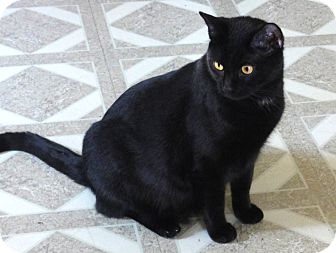Bombay Cat
Category: Cats

Facts about Bombay Cats, "Scientific name for Bombay Cat is Felis Catus". The "Bombay Cat" is a breed of short-haired domestic cat that is developed by reproduction of the black American Short-hair and the sable Burmese cats to create a cat of typically Burmese type, but with a smooth, tight black fur. The Bombay Cat is the name offered to black cats that belong to the Asian group. The Bombay Cat breeds have a black fur, nose, toes, and yellow eyes. The close-lying, shiny and smooth black fur is colored to the roots, with modest or without paling.
Appearance
In appearance, the Bombay Cat breed resembles a Burmese cat, but will be quite larger than and not as compact as the Burmese cats. The cranium of the show-quality Bombay Cat breed will be circular in shape with a short muzzle. Since the Bombay Cat breed is a combination of two different breeds, it is habitually hard to produce show-quality cats.
The Bombay Cat breed is a smooth, strong cat that appears in large copper penny eyes and a glossy midnight-black fur that looks like the black copyright leather. The mixture is stunning and resembles the mini-panther. The Bombay Cat medium-sized breeds carry a body weight that ranges from six pounds to 10 pounds (4.5 kg). Normally, male Bombay Cat breeds are heavier than the female ones.
Temperament
The Bombay Cat breed is an easygoing and broadminded cat who acquires life as it comes. The Bombay Cat breed is highly social that loves to be in the group of others. The Bombay Cat breeds are inclined to be friendly to their families and long for attention, and for this cause the Bombay Cat breed is greatly suitable for kids. The majority of Bombay Cats are dependents. However, grown-up Bombay Cat breeds are rather more self-governing than younger ones. The Bombay Cat look for attention from their proprietors and people around them habitually and hate being left these cats alone for a longer time. Even though the Bombay Cats like to be with people generally, they as well, tend to have a particular person whom they pay unique consideration in their lives.
It is not strange for the Bombay Cat breed to learn to play active games such as fetch or to walk on a leash, but the Bombay Cat breed has a status as a lap cat, too. Generally, the Bombay Cat breed is clever, good-nature, and attention-seeking cat. The Bombay Cat are inclined to manage well with other cats because they have a traditional pecking order in the family. The Bombay Cat have an extremely distinguishing hum and feel affection for snuggling. The fear of cats "Ailurophobia".
Bombay Cat breeds are the stranger-affable cats. The Bombay Cat will welcome the guests with a playful approach or with a curious glance. Some of the Bombay Cat breeds are indifferent or shy, maybe even hiding under skedaddling or furniture to another room.
Grooming
Some Bombay Cat breeds require extremely little grooming, whereas others need regular grooming to stay healthy and clean. The pet owner of the Bombay Cat breed should have an enough patience and time for the Bombay Cat breed that requires daily grooming.
Health
Generally, the Bombay Cat breed is healthy, but some of the troubles that have an effect on the Bombay Cat breed, such as extreme tearing of the eyes, Hypertrophic Cardiomyopathy, and the likelihood of breathing difficulties owing to the short muzzle of the cat. Owing to poor breeding practices, some Bombay Cat breeds are prone to some genetic health difficulties. This does not denote that every Bombay cat will develop these infections, but it just signifies that they are at an amplified risk. The average lifespan of the Bombay Cat breed ranges from 12 years to 16 years.
Bombay Cats on average sleep 13 to 14 hours a day and when they are awake, the spend a lot of time liking themselves to keep themselves clean. Bombay Cats help control rodents like small rats and mice where the live homes, warehouse, ect. A female Bombay Cat is called a "queen or molly", male Bombay Cat is called a "tom" and the name "clowder" is called a group and young or baby cats are called kittens.
Bombay Cats have very sharp hearing and their sense of smell is fantastic. The reason why Bombay Cats can squeeze through very small spaces is that they have free-floating clavicle bones that their shoulders are attach to their forelimbs. Bombay Cats can see at levels of light six time lower than a human, this is why cats can catch mice so easily at night. Bombay Cats outer ear uses 32 muscles to control it, and a human has only 6 muscles in its ear and a cat can move its ears 180 degrees. A Bombay Cat can move their ears independently.
The cat's hairball is called a "bezoar" (meaning a concretion or calculus found in the intestines or stomach of certain animals, in particular ruminants, formerly alleged to be an effective cure for poison). A Bombay Cat can climb up a tree well but can not climb head first down a tree, because all the claws on a cat’s paw points the same direction, to get down from a tree, a cat has to back down.
A Bombay Cat can run at a top speed of about 30 mph (48.2 km) over a short distance. A Bombay Cat rubs against a person to not only to be affectionate but also to mark out its territory. A Bombay Cats does not like water because its fur is not insulate it well when it gets wet. A Bombay Cat averages about 12 whiskers on both side of its face.

 Back To Category Cats
Back To Category Cats